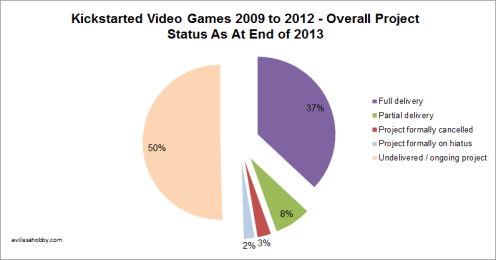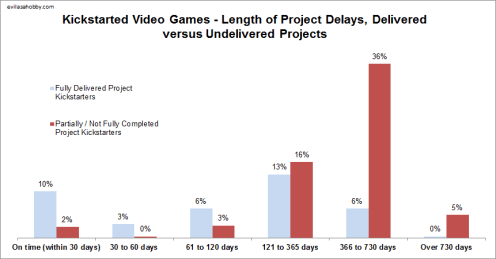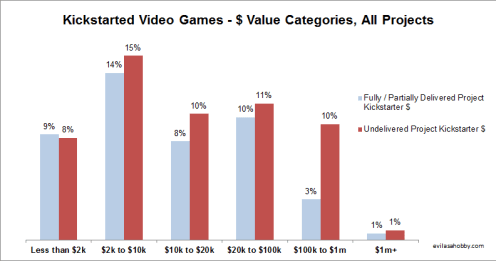Trending
Opinion: How will Project 2025 impact game developers?
The Heritage Foundation's manifesto for the possible next administration could do great harm to many, including large portions of the game development community.

Featured Blog | This community-written post highlights the best of what the game industry has to offer. Read more like it on the Game Developer Blogs or learn how to Submit Your Own Blog Post
Some analysis of successfully funded Kickstarter video games from 2009 to 2012. In short, only around one in three fully deliver the promised title to their backers.

Back about two years ago, someone challenged my wariness about video games funded through Kickstarter. “Where was the evidence that these crowdfunded games weren’t going to deliver? Wasn’t I just being a jerk by being so doubtful?” they asked me in broad terms.
This was possibly a rhetorical question, asked during the 2012 Kickstarter boom, but it struck me that no-one else had a hard answer to those questions.
So I did the passive aggressive thing, collected the data and analysed it. I did some (pretty rambling) analysis then, and recently went back and looked again at how Kickstarted video games were doing.
As a short description of my approach, I collected a list of the successfully funded Kickstarter video game projects from 2009 through to the end of 2012, then waited to the end of 2013 to see how many projects across this time frame officially delivered the title (mostly video games, with a smattering of other video game-related things, like books and OUYAs) as promised to their backers. I say ‘officially’ because some projects (example: OUYA again) may have formally launched into the market, but individual project backers may not have received the rewards they were promised.
It was thought that a year was a long enough period to wait to test out what the delivery rates for 2009 to 2012 – out of the 366 projects in the analysis, only 9 indicated they were targeting a 2014 release date. I’ve tried to ignore these 9 titles in the rest of the analysis.
Overall Delivery Rate is Worse Than Shaq’s Free Throw Percentage
The major finding of this analysis was that only around a third of successfully funded Kickstarter video games have fully delivered on their title over the indicated time period. If you include the number of partially delivered titles, such as the first episode of five being released or an iOS version being released with a PC version still on the way, this delivery result increases to about half of all Kickstarted video games.

The pie chart was used by Florence Nightingale to badger doctors into doing what she wanted them to do. True story.
(I’ll make the note that I haven’t included the release of alpha / beta versions or launch on Steam Early Access as a partial delivery, unless that was what the original Kickstarter pitch said was the end result. Titles in alpha / beta / Early Access are by definition unfinished and development on these games is hopefully ongoing.)
I’ve seen some comments that this delivery rate is pretty good, or at least in line with expectations about software development. Maybe that’s true, but I wonder how all those software project failures are dealt with by the people who funded them. Formal investors are likely to have some kind of contractual protection against a project being a write-off and I doubt software developers often just get to shrug their shoulders, go, “Eh, we tried,” and leave a failed project without any consequence.
Crowdfunding is a bit different in that it is a trust exercise. A Kickstarter backer trusts the project to deliver on its promises and ‘buys in’ at a reward level. Very, very few backers put money into a project but forgo the rewards offered – for example, only 244 out of the 34397 backers for Star Citizen aren’t assigned to a reward level. That’s less than 1% of backers who appear to be only putting in money to support a project without expecting anything in return, and it’s a figure that appears consistent with other Kickstarter projects I’ve looked at.
Failure to deliver violates this trust and damages the possibility of that person backing future projects. That’s why I consider a full delivery rate of only around 1 in 3 projects pretty poor – in the longer term, it makes crowdfunding video games a lot less viable as backers get burned and drop out, or only back projects that are ‘guaranteed’ not to fail.
The Waiting Game
Delays are perhaps to be expected among Kickstarted video game projects and a question was asked about how long backers have to wait for their project to release something. In short, only around one in ten Kickstarted video game delivers ‘on time’ (i.e. roughly within their Kickstarter estimated launch month) while almost half of projects have left their backers waiting a year or more over the original date listed in the pitch.

Dates are funny things to use in calculations. It just feels weird looking at the numbers.
For those wondering how an undelivered game can be ‘on time’, those 2% of titles were those promised at the end of 2013, when the analysis period ended.
In this instance, only full delivery is being counted, so there are some titles like Kentucky Route Zero that has released some episodes but hasn’t yet delivered its full amount. (It’s arguable that someone backing Kentucky Route Zero back in 2011 was aware that it was going to be an episodically released title – that change was first announced via Kickstarter in October 2012. Backers may have been made aware of this change earlier through direct newsletters though.) However, only a small proportion of Kickstarted video games have been classified as partially delivered (8%), so the majority of titles that look delayed above are exactly that.
All in all, if you are evaluating a Kickstarter project before you back it, it’s pretty safe to add another 12 months to that estimated delivery date and consider if you’re willing to wait that long before receiving what you contributed money towards.
Is It The Money?
A question was asked if projects with larger funding targets and / or higher achieved amounts took longer to deliver. There’s some evidence to support that idea, with titles that received $100k or more being disproportionately undelivered (admittedly on a small numerical base).

I was interested to see that the majority of successful Kickstarted video games from 2009 to 2012 received $20k or less from crowdfunding – that’s not a lot in game development terms.
If you combine these dollar figures with the delays over the estimated launch times, it opens a question about how well these projects can really plan their budgets. A title that receives crowdfunding covering four months of development but actually takes ten months to complete potentially leaves a big funding hole that the developer(s) need to fill, which is a risk to the successful delivery of the project.
Conclusion: I’m Still A Jerk About Kickstarter For Video Games
Following all this analysis, I’m still pretty comfortable being wary about Kickstarted video games. I’m not willing to spend money and accept the risk of a project failing. If a project succeeds, then I can always purchase it through the normal channels.
Part of the point behind crunching these numbers is to provide some hard(er) figures around the risk of being a backer. Too often it is only the successful titles that get the attention, which I believe distorts how people see risk around crowdfuning. For all those who are happy to accept that risk – and a lot of backers ask for refunds when a project fails, so don’t think that all those put money into a Kickstarted game will accept losing it – then hopefully the above at least has served as something to think about.
Caveats
You can find most of the data I used to develop this analysis here (although the recent date-based analysis isn’t there year and will go up across the course of the week). The vast majority of the data from Kickstarter was manually entered and I’ve done my best to minimise any errors in my work.
Probably the largest contention with this analysis will be around the classification of the titles’ completion states. I’ve done my best to find out how each of the 366 projects have been going, but that’s not easy when updates are hidden behind backer-only protections or developers have stopped updating the Kickstarter site and instead rely of personal blogs and / or Facebook to release status updates.
Read more about:
Featured BlogsYou May Also Like